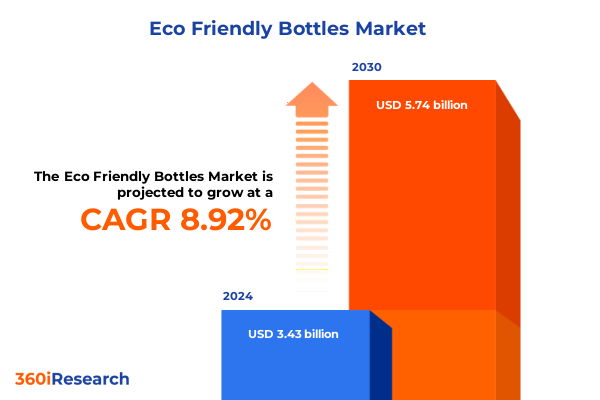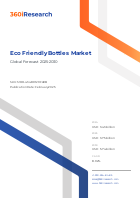The Eco Friendly Bottles Market size was estimated at USD 3.43 billion in 2024 and expected to reach USD 3.75 billion in 2025, at a CAGR 8.92% to reach USD 5.74 billion by 2030.

Introduction to the Evolving Landscape of Eco-Friendly Bottles
In today's rapidly evolving marketplace, the eco-friendly bottle sector is emerging as a critical component of environmental sustainability and consumer health. Over the past decade, rising environmental concerns coupled with advances in manufacturing technology have driven both demand and innovation in this industry. New materials and production methods are reshaping traditional product lines, ensuring that sustainability is not sacrificed for functionality. The use of renewable materials and cutting-edge recycling processes has changed the way products are designed and distributed. With an increasing shift in consumer behavior towards products that reduce harmful waste and lower carbon footprints, this sector is witnessing unprecedented growth. Industry experts agree that this dynamic market not only serves environmentally conscious consumers but also presents new profit avenues for businesses seeking to adapt quickly to changing market conditions. As regulatory bodies worldwide are pushing stricter standards and government incentives continue to mount, brands are compelled to reassess their portfolios and invest in eco-friendly solutions. This introductory overview sets the stage for deeper analysis by exploring transformative industry shifts, segmentation strategies, regional market insights, company dynamics, strategic recommendations, and actionable calls for future engagement.
Transformative Shifts Reshaping the Eco-Friendly Bottles Sector
The eco-friendly bottle market has experienced a series of transformative shifts over the last several years. Rapid technological advancements have redefined production methods while environmental imperatives have pushed companies to innovate at unprecedented rates. Manufacturers are now integrating design strategies that focus on longevity and recyclability, significantly reducing waste and improving performance. Moreover, evolving consumer preferences have influenced product design and functionality; buyers are increasingly drawn to items that balance aesthetic appeal with sustainability. In response, producers are transitioning from conventional materials to those that offer greater eco-credentials, including materials that are either biodegradable, compostable, or highly durable. There has also been a strategic pivot towards products that are both versatile and functional, catering to smaller ecological footprints without compromising quality. As global policies tighten and competition intensifies, market players are optimizing their portfolios by adopting agile manufacturing processes and leveraging eco-centric innovations. In this environment, the integration of technological, environmental, and consumer trends has proven vital for brands seeking to navigate the evolving market dynamics and secure a competitive edge.
Key Segmentation Insights into the Eco-Friendly Bottles Market
Segmenting the eco-friendly bottles market reveals a nuanced landscape that helps in understanding diversified consumer needs and manufacturing capabilities. Analysis based on product type investigates the differences between biodegradable bottles, compostable bottles, reusable bottles, and single-use bottles, each carrying unique market benefits and challenges. Evaluating material type, the sector studies options ranging from aluminum, bamboo, glass, paper, polylactic acid (PLA), to stainless steel, while noting that bamboo is further dissected into processed and raw varieties; glass splits into borosilicate and tempered types; PLA is analyzed across the differences between advanced biomaterials and basic formulations; and stainless steel is segmented into insulated and non-insulated variations. Further segmentation based on capacity examines market preferences for different sizes including options such as one liter, 500 milliliters, 750 milliliters, and those exceeding one liter. Additionally, the study of end-users identifies specific demands from commercial entities, households, and institutional buyers. The differentiation deepens when considering applications, which span daily consumption, sports and fitness, and travel coupled with convenience, noting that sports and fitness include specialized sectors like gym and exercise as well as water activities. Moreover, distribution channels are assessed between offline retail, encompassing departmental stores, specialty stores, and supermarkets, and online retail. Other segmentation avenues include consumer age groups, design aesthetics ranging from classic to customized and trendy collections, usage frequency qualifiers from heavy duty to occasional, closure types including flip top lids, sipper caps, and twist-off lids, and finally a price range criterion that differentiates economical, mid-range, and premium offerings. This comprehensive segmentation provides valuable insights into consumer preferences, production trends, and market potential.
- Product Type
- Material Type
- Capacity
- End-User
- Application
- Distribution Channel
- Consumer Age Group
- Design
- Usage Frequency
- Closure Type
- Price Range
Regional Perspectives and Market Penetration Insights
Examining the geographic distribution of the eco-friendly bottles market reveals significant regional variations that are critical to understanding global market penetration and strategic planning. Analysis across regions such as the Americas, Europe, Middle East & Africa, and Asia-Pacific shows varied levels of market maturity and consumer behavior. In the Americas, for instance, market dynamics are marked by a strong consumer base and a high rate of adoption due to increasing environmental awareness and robust regulatory frameworks. The Europe, Middle East & Africa regions are characterized by stringent eco-regulations and a rapidly growing trend towards sustainable packaging solutions, encouraging innovation and compliance among manufacturers. Meanwhile, the Asia-Pacific market stands out for its significant growth potential, driven by massive consumer populations and a rising awareness regarding sustainability. Together, these regions illustrate an interconnected global market where regional trends create ripple effects, shaping product development, distribution strategies, and cross-border partnerships. By understanding these regional differentiators, industry stakeholders can tailor their approaches to meet local demands while leveraging global best practices, ensuring alignment with both regional preferences and overarching international sustainability standards.
- Americas
- Asia-Pacific
- Europe, Middle East & Africa
Key Company Insights and Competitive Landscape
A deep dive into major players within the eco-friendly bottles market reveals a competitive landscape populated by both established global brands and innovative niche companies. Companies such as Ampulla Ltd. and Asahi Group Holdings, Ltd. have long been recognized for incorporating sustainability into their core profiles. Similarly, Billerud AB and Carlsberg A/S have made significant investments in eco-friendly materials, thereby setting performance benchmarks in the industry. Other influential players like Jabil Inc. and Kagzi Water Bottle have synergistically blended traditional design with modern eco-technologies to offer products that resonate with a broad consumer base. Emerging brands, including One Green Bottle and Paper Water Bottle, Inc., are entering the market by focusing on sustainable production practices and niche market segments. Additionally, giants like PepsiCo, Inc. and Robert Cullen Ltd. have diversified their portfolios to include both premium and mid-range offerings that meet shifting consumer demands. Further contributing to the competitive narrative, Sidel, Inc., SKS Bottle & Packaging, Inc., The Friendly Turtle Company Ltd., VICKEREY, and Wearth London Limited have fueled innovation with strategic expansions and collaborations, aiming to capture wider market segments. This diverse ecosystem underscores the importance of harmonizing innovation, design, and environmental responsibility in order to maintain competitive advantage and capture evolving market opportunities.
- Ampulla Ltd.
- Asahi Group Holdings, Ltd.
- Billerud AB
- Carlsberg A/S
- Jabil Inc.
- Kagzi Water Bottle
- One Green Bottle
- Paper Water Bottle, Inc.
- PepsiCo, Inc.
- Robert Cullen Ltd.
- Sidel, Inc.
- SKS Bottle & Packaging, Inc.
- The Friendly Turtle Company Ltd.
- VICKEREY
- Wearth London Limited
Strategic Recommendations for Industry Leaders in the Eco-Friendly Bottles Sector
For industry leaders looking to further capitalize on the growth of the eco-friendly bottles market, a multi-faceted strategy is essential. First, a rapid yet measured investment in research and development is crucial to drive forward innovations in sustainable materials and processing techniques. Leaders should focus on integrating cutting-edge technologies that reduce production waste and optimize energy usage. Expanding digital transformation initiatives can improve supply chain transparency, bolster inventory management, and create enhanced forecasting models in line with fluctuating market demands. Furthermore, forging strategic partnerships both within and outside the industry can foster a culture of innovation, enabling the sharing of best practices and the co-development of breakthrough products. It is also advisable for decision-makers to focus on aligning their product portfolios by balancing eco‐credentials with performance and durability, ensuring that products meet both environmental and consumer expectations. Emphasizing customer education and engagement through tailored marketing campaigns will deepen brand loyalty and drive repeat purchases. Leaders should closely monitor emerging trends and regional regulatory updates, adapting operations to meet evolving compliance standards. At the same time, investing in market analytics will offer pivotal insights into consumer behavior, allowing for agile adjustments to product offerings and distribution channels. This strategic approach not only enhances competitive positioning but also ensures long-term sustainability in a rapidly evolving marketplace.
Ask ResearchAI anything
World's First Innovative Al for Market Research
Conclusion: Embracing a Sustainable Future in Bottle Manufacturing
The evolving landscape of eco-friendly bottles presents a compelling narrative of innovation driven by sustainability and consumer demand. As market dynamics shift, it is clear that environmental considerations are no longer a niche priority but a mainstream imperative, influencing every facet of production, design, and distribution. The detailed segmentation analysis highlights the market's broad diversity, showcasing the importance of tailoring product offerings to meet unique consumer needs while keeping pace with technological and material advancements. Regional insights further illustrate that this market is truly global, with distinct trends in the Americas, Europe, Middle East & Africa, and Asia-Pacific shaping a resilient and interconnected industry. The competitive environment underscores that traditional and emerging players alike must continuously innovate, collaborate, and refine their strategies to secure a niche in this rapidly maturing market. Ultimately, the drive towards sustainable practices in eco-friendly bottle manufacturing is not just a response to regulatory pressures, but also a proactive embrace of a greener future, ensuring that both businesses and consumers can contribute to and benefit from improved environmental outcomes.
- Preface
- Research Methodology
- Executive Summary
- Market Overview
- Market Insights
- Eco Friendly Bottles Market, by Product Type
- Eco Friendly Bottles Market, by Material Type
- Eco Friendly Bottles Market, by Capacity
- Eco Friendly Bottles Market, by End-User
- Eco Friendly Bottles Market, by Application
- Eco Friendly Bottles Market, by Distribution Channel
- Eco Friendly Bottles Market, by Consumer Age Group
- Eco Friendly Bottles Market, by Design
- Eco Friendly Bottles Market, by Usage Frequency
- Eco Friendly Bottles Market, by Closure Type
- Eco Friendly Bottles Market, by Price Range
- Americas Eco Friendly Bottles Market
- Asia-Pacific Eco Friendly Bottles Market
- Europe, Middle East & Africa Eco Friendly Bottles Market
- Competitive Landscape
- List of Figures [Total: 39]
- List of Tables [Total: 777 ]
Take the Next Step: Secure Your Competitive Advantage
By delving into the comprehensive market research report, decision-makers can unlock a wealth of information that will empower them to strategically position themselves at the forefront of the eco-friendly bottle industry. The report provides critical insights into market segmentation, regional trends, competitive dynamics, and actionable recommendations that address every facet of the industry. With detailed analytics and data-driven foresight, this resource is an indispensable tool for those looking to make informed decisions and drive growth. For further discussion and to explore these comprehensive insights, please reach out to Ketan Rohom, Associate Director, Sales & Marketing, to begin your journey towards a more sustainable and profitable future. This opportunity underscores the need for immediate action in response to dynamic market forces—don’t let your business miss the chance to lead the transition towards a greener tomorrow.

- How big is the Eco Friendly Bottles Market?
- What is the Eco Friendly Bottles Market growth?
- When do I get the report?
- In what format does this report get delivered to me?
- How long has 360iResearch been around?
- What if I have a question about your reports?
- Can I share this report with my team?
- Can I use your research in my presentation?




